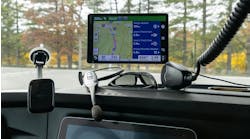ATLANTA. When it comes to adopting electronic logging devices (ELDs), a panel of three fleet executives here at McLeod Software’s 2017 User Conference argued that the biggest challenge is not the acceptance and subsequent use of that technology by drivers.
Rather it is the “culture change” the load planning and freight sales departments need to undergo to ensure length of hauls and shipment pricing reflect the available hours clocked by ELDs.
“This is not baseball; you don’t get three strikes,” explained Lamar Quinn, general manager at R.E. Garrison Trucking of Vinemont, AL, which switched to electronic logging in 2015. “ELDs tell you where the ‘bad freight’ is. Planning is huge; we need to select the right freight and we needed our sales team to educate our customers on proper lengths of haul. This changed our entire culture.”
For R.E. Garrison, moving to ELDs meant finding one-day freight moves with 494 mile lengths of haul or two-day freight moves of 1,000 miles. “We needed to get out of that 600- to 700-mile length or haul or price it very differently,” Quinn explained.
Charging for detention time became critical as well, he added. “If a shipper wants us to go to an unfavorable consignee with excessive dwell time, we’ll give them that truck for a $650 fee – whether we then get out early or not,” Quinn noted.
While driver productivity initially declined when the fleet switched to electronic logs, he said that as the motor carrier’s sales team concentrated on bringing in the “right freight,” productivity increased 17% – resulting in a nearly 30% gain in weekly per truck revenue, going from $3,600 a week to $4,400 per week.
Quinn pointed out, too, that improving the quality of freight via ELDs is allowing R.E. Garrison to plan better home time for its drivers.
“The ability for drivers to have quality home time now truly exists thanks to ELDs,” he said. “It’s part of the plan; we couldn’t do it before.”
Jerry Harris, vice president at Gypsum Express, a 700-truck flatbed carrier based in Baldwinsville, NY, switched to electronic logging five years ago at a time when it employed 500 drivers – and only lost two drivers as a result of that switch.
“Leadership proved huge; our owner got up and said we’re going to see this through and to bear with us,” Harris explained. That “push from the top got us over the top” in terms of adopting ELDs, he added.
“The [hours of service] rules have not changed; just how we are recording them has changed,” Harris stressed.
Load planners at Gypsum faced the biggest challenge when the fleet moved to electronic logging, he pointed out. “Too often we’d been reactive; now, with that clock running, it forces you to really plan,” he said. “We need to be cognizant of whether that clock is running or not running.”
Changing the mindset of customers proved to be the tough task faced by the sales team. “We had to tell customers when loads could not be legally hauled,” Harris said. “We also had to work with customers that demanded firm delivery times but would not provide parking at their site.”
Often, the outside world “still doesn’t get it” in terms of how ELDs are changing the manner in which freight can – and cannot – be hauled, he explained.
Another key role being affected by the shift to electronic logging is that or driver managers, noted Paul Davis, manager of information technology for Best Logistics Group of Kernersville, NC. His operation, which switched to ELDs three years ago, now knows exactly what “real time” is available to its drivers.
“It’s been a rude awakening to logistics people who never cared about hours,” he said. “Drivers now know when their day starts and when it ends; there is no ambiguity. It’s really changed what they are supposed to do and has put them in more control.”




